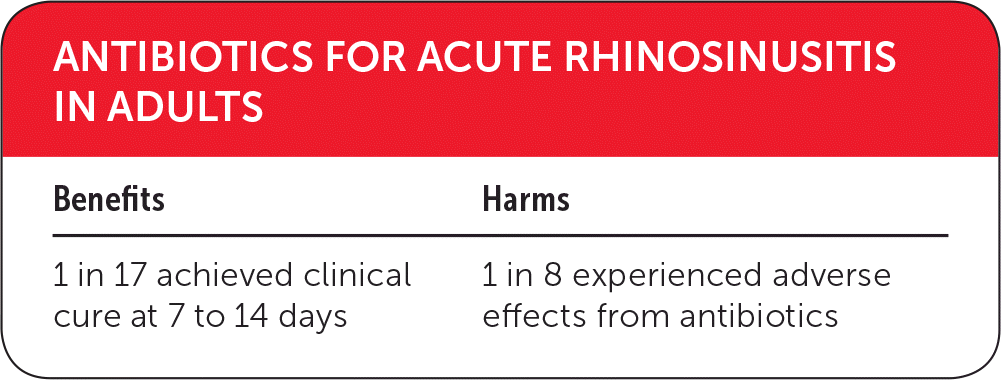
Am Fam Physician. 2019;100(7):online
Author disclosure: No relevant financial affiliations.


| Benefits | Harms |
|---|---|
| 1 in 17 achieved clinical cure at 7 to 14 days | 1 in 8 experienced adverse effects from antibiotics |
Details for This Review
Study Population: Adults with suspected acute rhinosinusitis (symptoms for 30 days or fewer)
Efficacy End Points: Clinical cure (resolution or improvement of major symptoms)
Harm End Points: Adverse effects from antibiotic use
Narrative: Acute rhinosinusitis is a common condition encountered by clinicians in ambulatory and emergency department settings. It is characterized by inflammation of nasal passages and sinuses, resulting in purulent nasal discharge, sinus tenderness, and facial pain. Most cases are caused by a viral or self-limiting bacterial infection, neither of which require treatment with antibiotics.1 Despite longstanding guidelines that recommend limiting the use of antibiotics to a small subset of patients, most patients continue to be prescribed antibiotics.2
The Cochrane review examined data on benefits and harms associated with the use of antibiotics in adults with acute rhinosinusitis (symptoms for 30 days or fewer).3 The rate of clinical cure without antibiotics after one and two weeks was 46% and 64%, respectively. The definition of clinical cure varied depending on the study but was usually defined as resolution or improvement of major symptoms.
The Cochrane review categorized the participants into three groups: those with rhinosinusitis diagnosed clinically, radiographically, and by computed tomography (CT). The use of antibiotics was associated with a significant increase in the cure rate of clinically diagnosed rhinosinusitis (odds ratio [OR] = 1.25; 95% CI, 1.02 to 1.54; 5% absolute risk difference [ARD]; number needed to treat [NNT] = 19; high-quality evidence), radiographically diagnosed rhinosinusitis (OR = 1.57; 95% CI, 1.03 to 2.39; 10% ARD; NNT = 10; moderate-quality evidence), and CT-diagnosed rhinosinusitis (OR = 4.89; 95% CI, 1.75 to 13.72; 25% ARD; NNT = 4; moderate-quality evidence; one trial).3 Overall, antibiotics increased the rate of cure by 6% (absolute risk increase), corresponding to an NNT of 17 (OR = 1.38; 95% CI, 1.15 to 1.65).3
Adverse events were significantly increased with the use of antibiotics (OR = 2.21; 95% CI, 1.60 to 2.77; 12.5% ARD; number needed to harm = 8). The type of adverse events varied, with the most common being gastrointestinal effects such as diarrhea.3 Secondary outcomes (such as resolution of purulent secretion, resolution of pain, illness duration, and restriction of daily activities) could not be quantitatively assessed because of data heterogeneity.
Caveats: The findings of the Cochrane review might not be generalizable to all patients with rhinosinusitis. The meta-analysis excluded or did not consider patients with severe symptoms, children, immunocompromised patients, or those with chronic symptoms.
There was a higher cure rate in patients diagnosed by CT, but the usefulness and generalizability of this particular finding are limited because the data were derived from a single trial. Moreover, imaging is not routinely used in patients with acute rhinosinusitis, and patients who require imaging (e.g., those with chronic rhinosinusitis) may respond differently to antibiotics than the patients more commonly seen in emergency departments or outpatient offices. For most patients, the cost and risk of radiation exposure outweigh the benefit of routine imaging for diagnosis, even if this is useful in identifying individuals who are more likely to benefit from antibiotics.
Some of the more serious adverse effects of antibiotics that are uncommon or more difficult to quantify (e.g., allergic reactions, Clostridium difficile infection, development of antibiotic resistance) were not reported in this analysis.
The Infectious Diseases Society of America1 and the American Academy of Otolaryngology–Head and Neck Surgery4 recommend observation and symptomatic management similar to that of acute viral rhinosinusitis for acute uncomplicated sinusitis. These guidelines recommend antibiotics in patients after about seven days if symptomatic management is ineffective.1,4
We assigned a color recommendation of red (no benefits) for this treatment because of the relatively high rate of reported adverse effects and the high likelihood of resolution of symptoms with supportive care and symptomatic management. Our recommendation is to follow existing guidelines and use antibiotics only selectively in patients with acute rhinosinusitis.
